KiloVault HLX+ batteries, serious quality and value
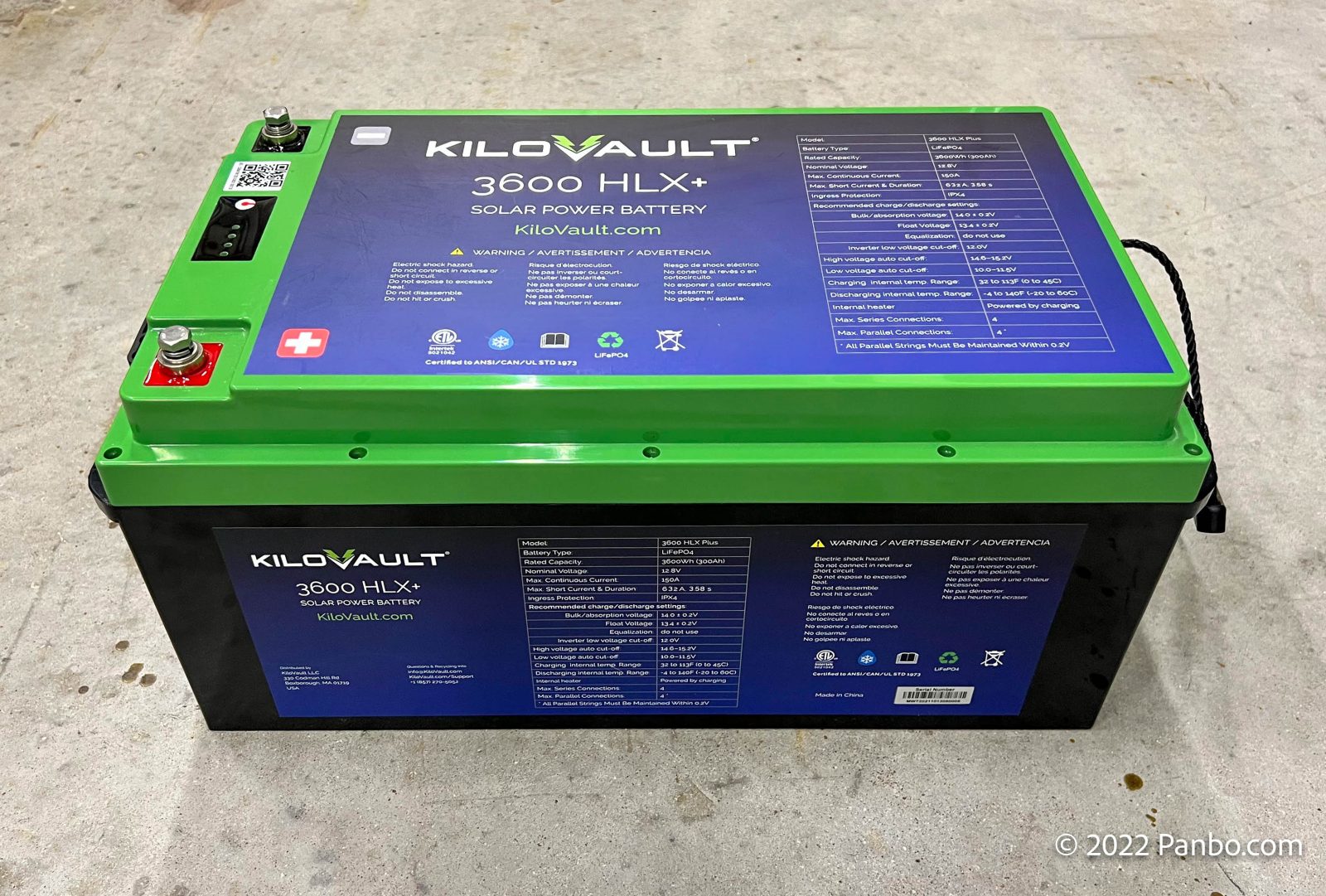
KiloVault might be a relatively new name in lithium iron phosphate (LiFePO4) batteries, but I’d expect to hear a lot more about them based on what I’ve seen so far. The HLX+ series of batteries are well-made, drop-in-style batteries with lots of capabilities at an affordable price point. I’ll be installing a pair of the 300 amp hour batteries in my RV, but first, let’s get to know the batteries better.
The KiloVault HLX+ series are drop-in style LiFePO4 batteries. A quick note about the term drop-in: I think whoever coined the term for drop-in is also responsible for redefining the word unlimited with cellular phone rate plans. No LiFePO4 batteries are truly drop-in replacements for lead-acid batteries. When switching to LiFePO4 batteries, the entire DC system needs to be evaluated for compatibility with the batteries. It’s critical to confirm that your charge sources are compatible and that your over-current protection is up to snuff. If you’re not sure how to accomplish these tasks, please seek the advice of a pro!
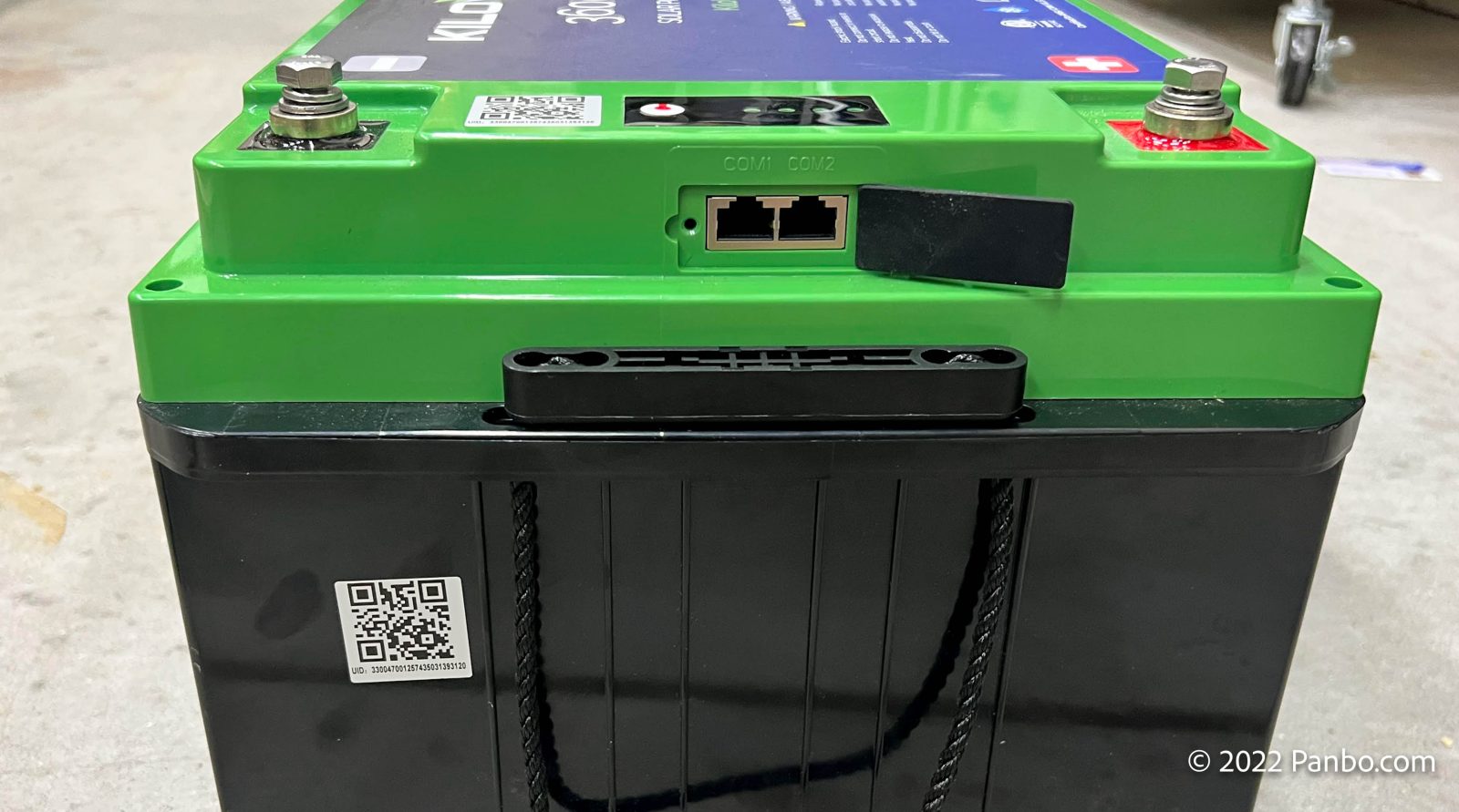
The HLX+ series of batteries have a couple of features rarely found on drop-in batteries. In fact, I’m not entirely sure what category these batteries fit, nor if it really matters. First, there are external communications ports on each battery. KiloVault has developed a communications bridge for communications between multiple batteries in a bank, which they expect to release very soon. Additionally, all of the HLX+ batteries, include heaters to allow low-temperature charging.
KiloVault HLX+ batteries are available in 100, 200, or 300 amp hour sizes at 12-volts. They don’t offer higher voltage batteries, but they support configurations up to four parallel strings of four series batteries. That’s a total of 16 batteries providing 1,200 amp hours of 48-volt power or 14.4kwh per string for a total of 57.6kWh with 4 strings.
| Battery | Capacity (AH) | Heating? | External CANBus Comm | Cost | Cost per Watt Hour |
| Battle Born 100Ah Heated | 100 | Yes | No | $949 | $0.74 |
| BattleBorn 270Ah 8D | 270 | No | No | $2,299 | $0.67 |
| Dakota 12v 100Ah DC | 100 | No | No | $899 | $0.70 |
| Dakota 12v 200Ah DC | 200 | No | No | $1,699 | $0.66 |
| Dakota 12v 277Ah DC – metal case | 277 | No | No | $2,399 | $0.68 |
| KiloVault 1200 HLX+ | 100 | Yes | Yes | $855 | $0.67 |
| KiloVault 2400 HLX+ | 200 | Yes | Yes | $1,545 | $0.60 |
| KiloVault 3600 HLX+ | 300 | Yes | Yes | $2,145 | $0.56 |
| Lithionics 12V130A | 130 | No | Yes | $1,449 | $0.87 |
| Mastervolt MLI Ultra 12/1250 | 100 | Yes | Yes N2K, CZone and MasterBus | $1,749 | $1.40 |
When compared to other drop-in batteries like BattleBorn and Dakota, the HLX+ batteries are similar, but a little bit cheaper per watt-hour. The differences get stark when compared to system integrated batteries like Lithionics and Mastervolt’s MLI series. But, the Lithionics and Mastervolt batteries use contactors instead of FETs to control the flow of current. I’ll talk a lot more about FETs below, but the main difference is the current handling abilities of these two approaches.
Tearing down a battery
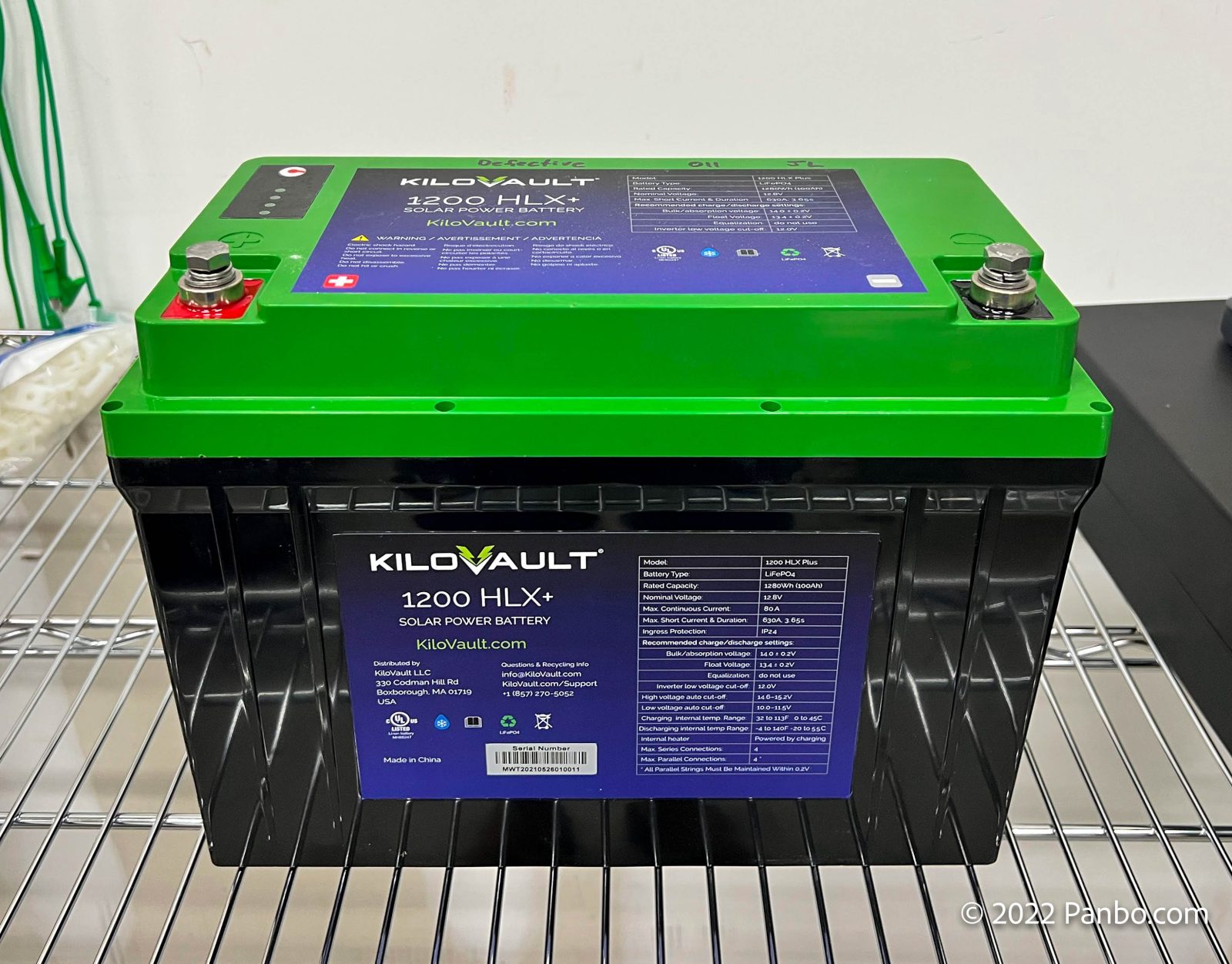
I asked if KiloVault could provide a defective battery to tear down so I could see how it’s put together and the quality of the components. They were happy to oblige. I think this may say more about the quality of their battery than anything else I’ll say. They’re confident enough in how it’s built to provide me one to tear apart. I must say, their confidence seems well placed.
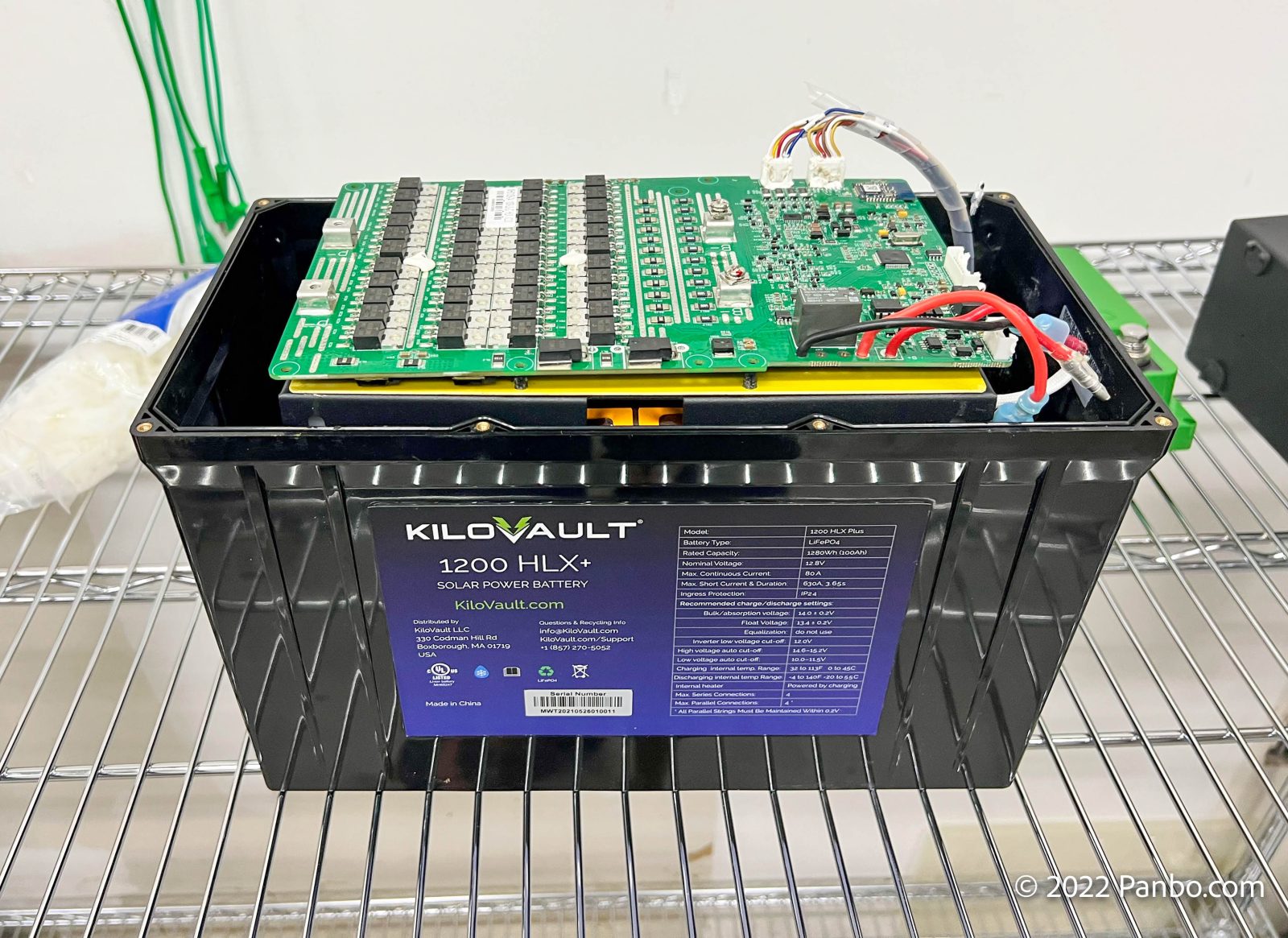
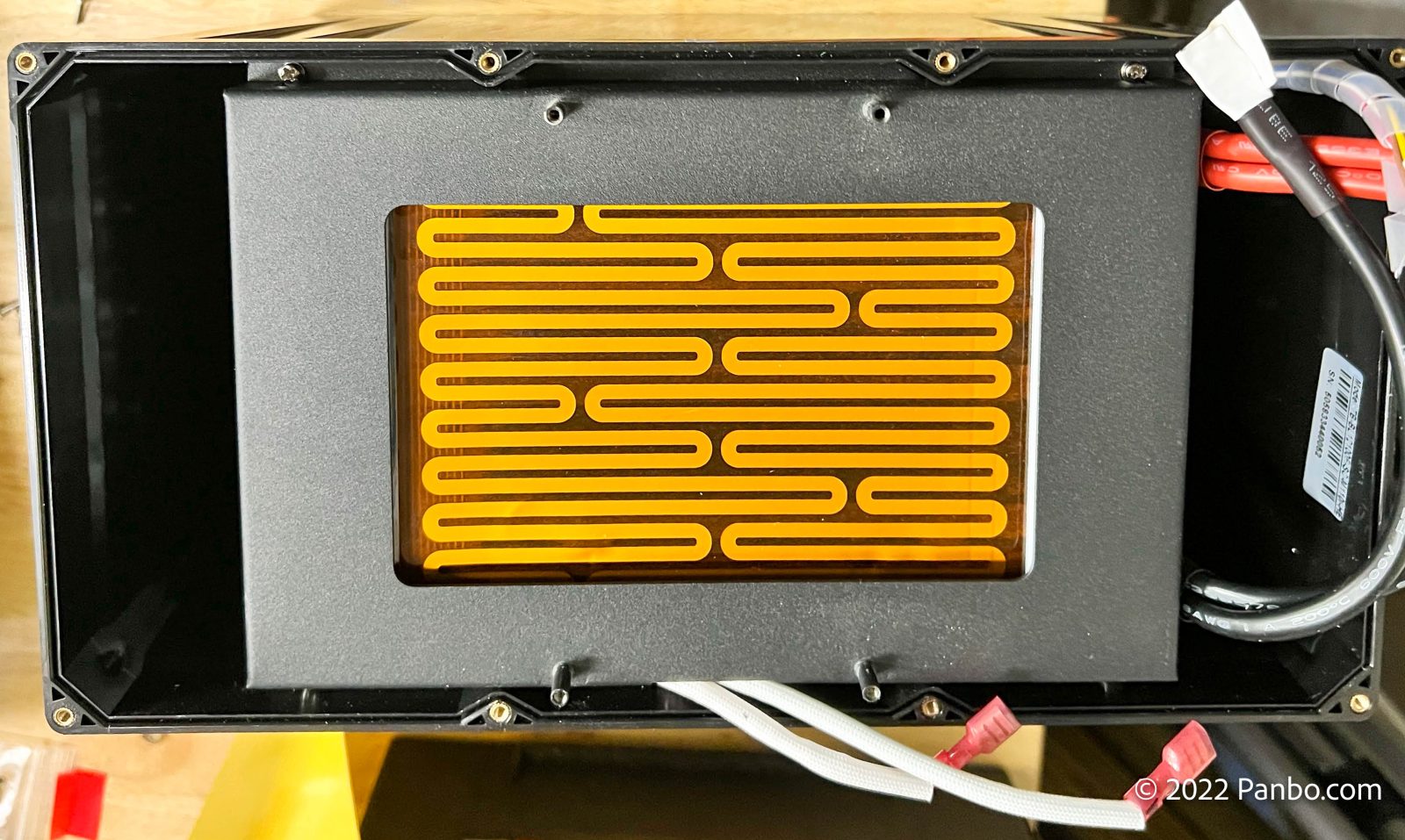
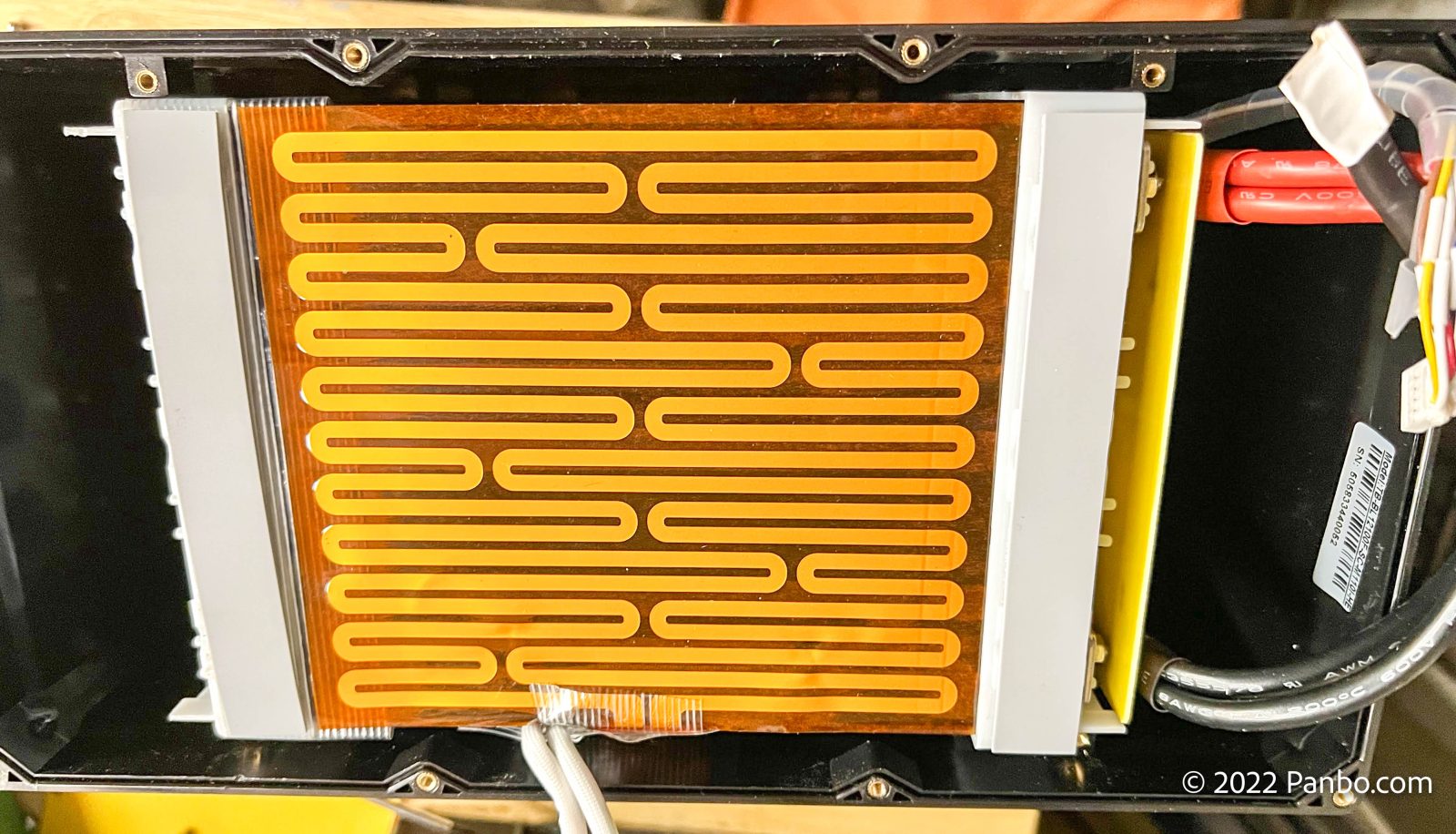
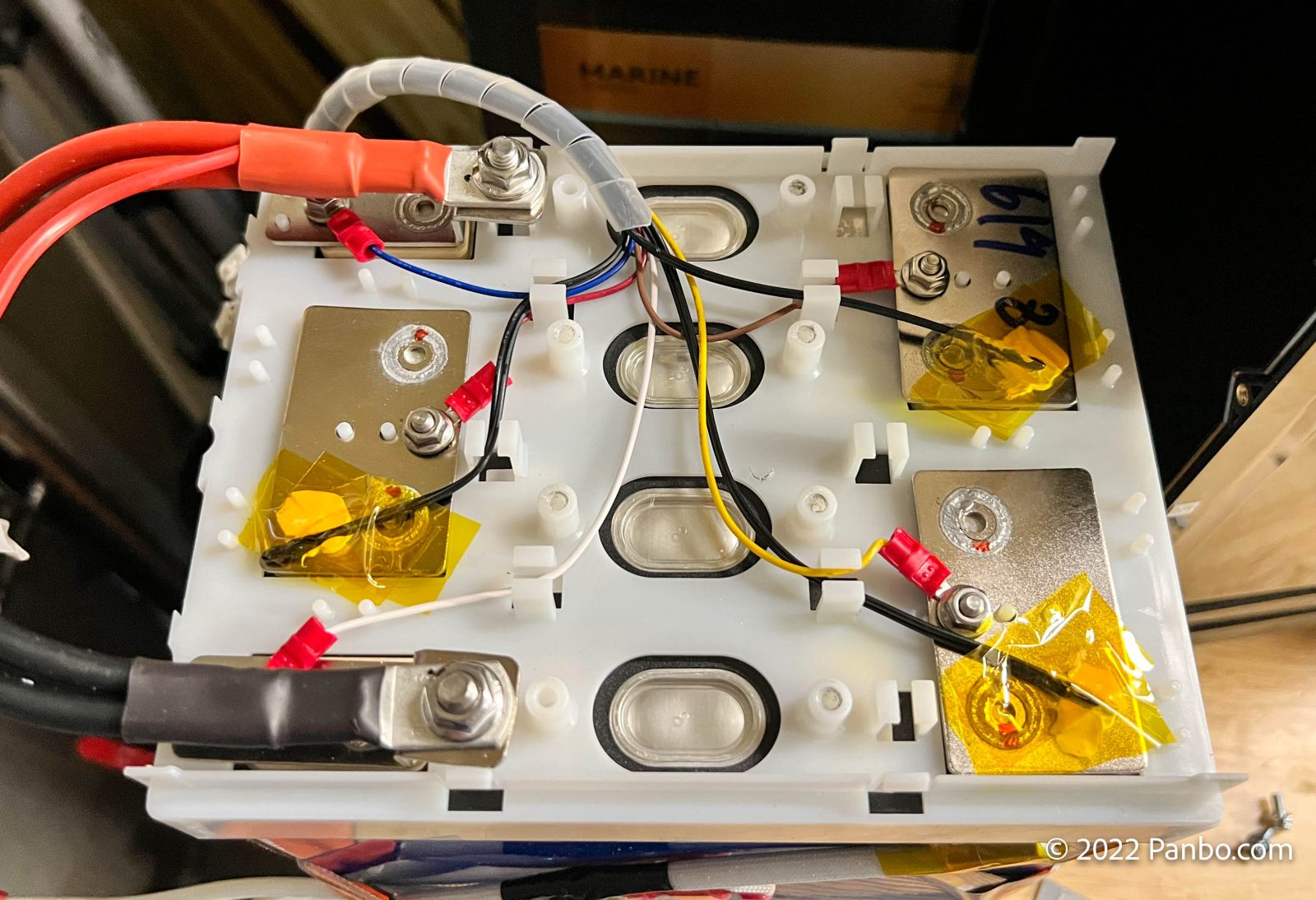
If you’re like me, you’ve probably watched a few of Will Prowse’s teardown videos. They usually involve an oscillating tool to get the case opened and frequently, somewhat disappointing components and build practices. Well, tearing down the KiloVault battery was a completely different experience. First, the 100 amp hour battery is secured by eight easily removed Philips head screws. Once opened, I found beefy metal mounts and heat sinks holding everything in place.
The individual cells are nicely secured in a plastic tray top and bottom. Both positive and negative terminals are fed by a pair of 8 AWG wires with 200-degree-celsius insulation. I was also happy to see not one but three temperature sensors on the cell tops. Three temperature sensors spread across the cells helps ensure a thermal anomaly will be quickly detected by the BMS and appropriate action taken.
BMS compared
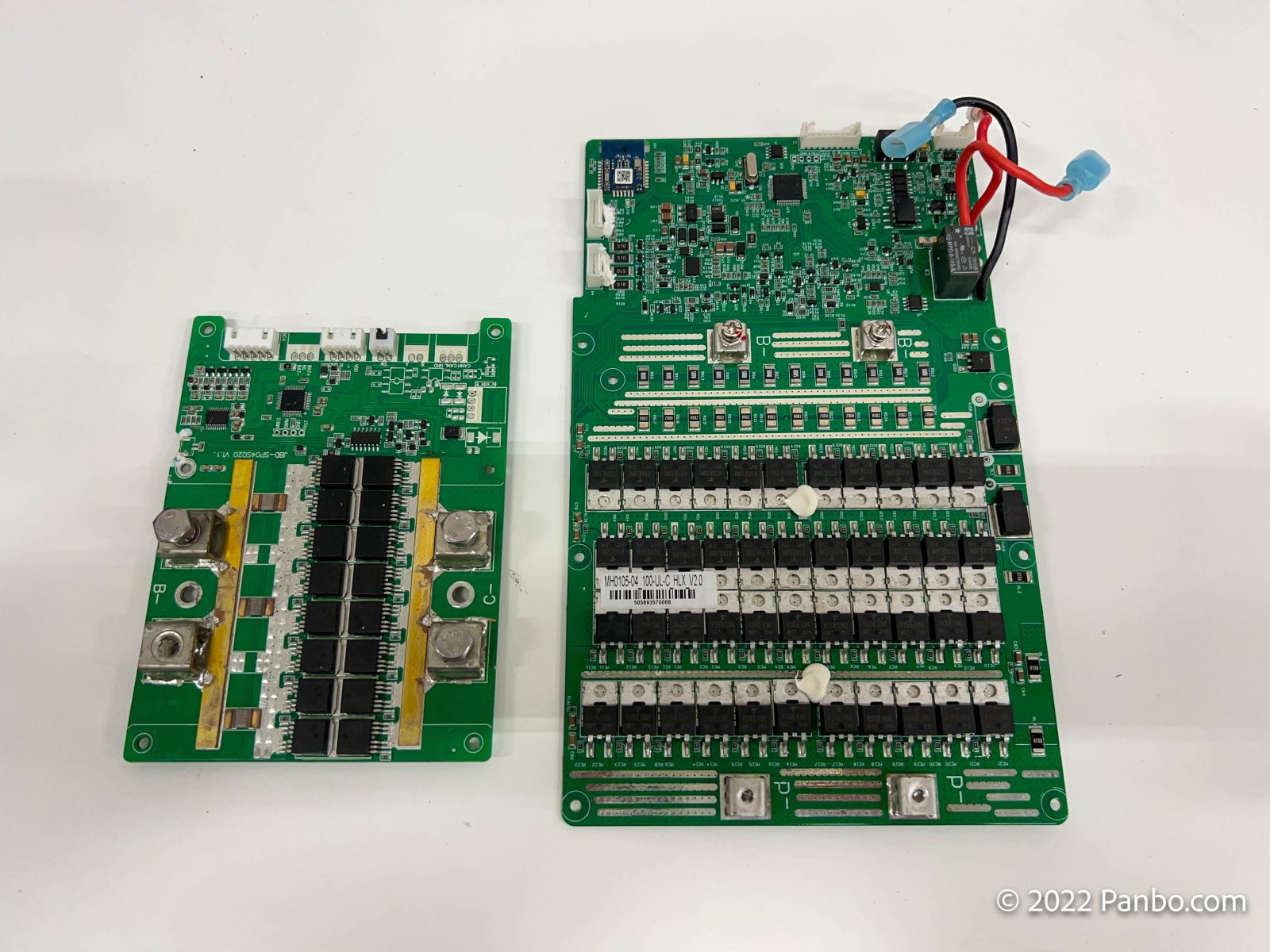
The first thing I noticed when I opened the battery is the size of the BMS. The picture above compares the size of an Overkill Solar 120 amp BMS to the KiloVault’s 100 amp BMS. The rows of chips running vertically down the bottom center of the Overkill and horizontally across the bottom of the KiloVault BMS are field-effect transistors or FETs. FETs control the flow of energy through the BMS, but they also generate a great deal of heat.
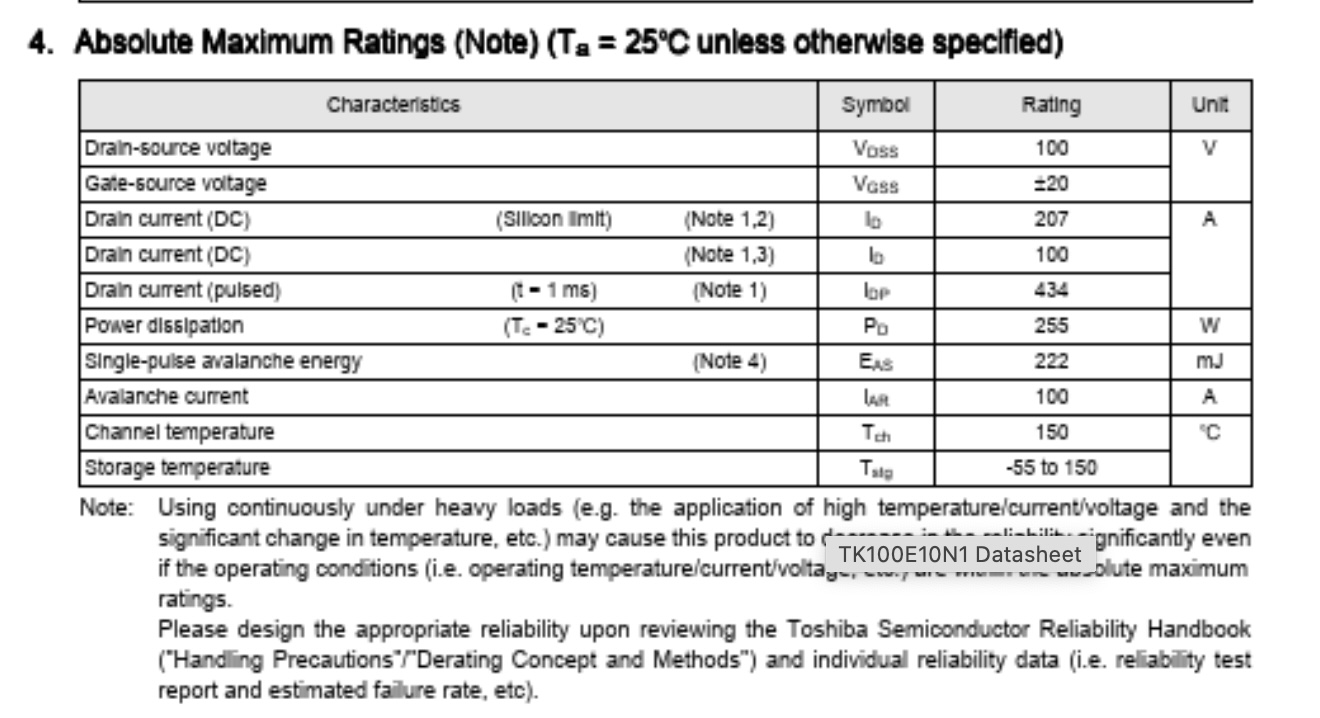
The picture above is an excerpt from Toshiba’s spec sheet for the FETs used on the KV BMS. Take a look at the note about reduced reliability from operating the FETs near their limits. The KV BMS has 44 FETs for a 100 amp rating, the Overkill Solar BMS has 32 FETs and a 120 amp rating. That means each FET on the KV BMS handles up to 2.27 amps, while each FET on the Overkill BMS handles up to 3.75 amps. The more current a FET handles, the more heat it generates and the shorter it will live. The FETs on the KV BMS are handling almost 40-percent less current at peak.
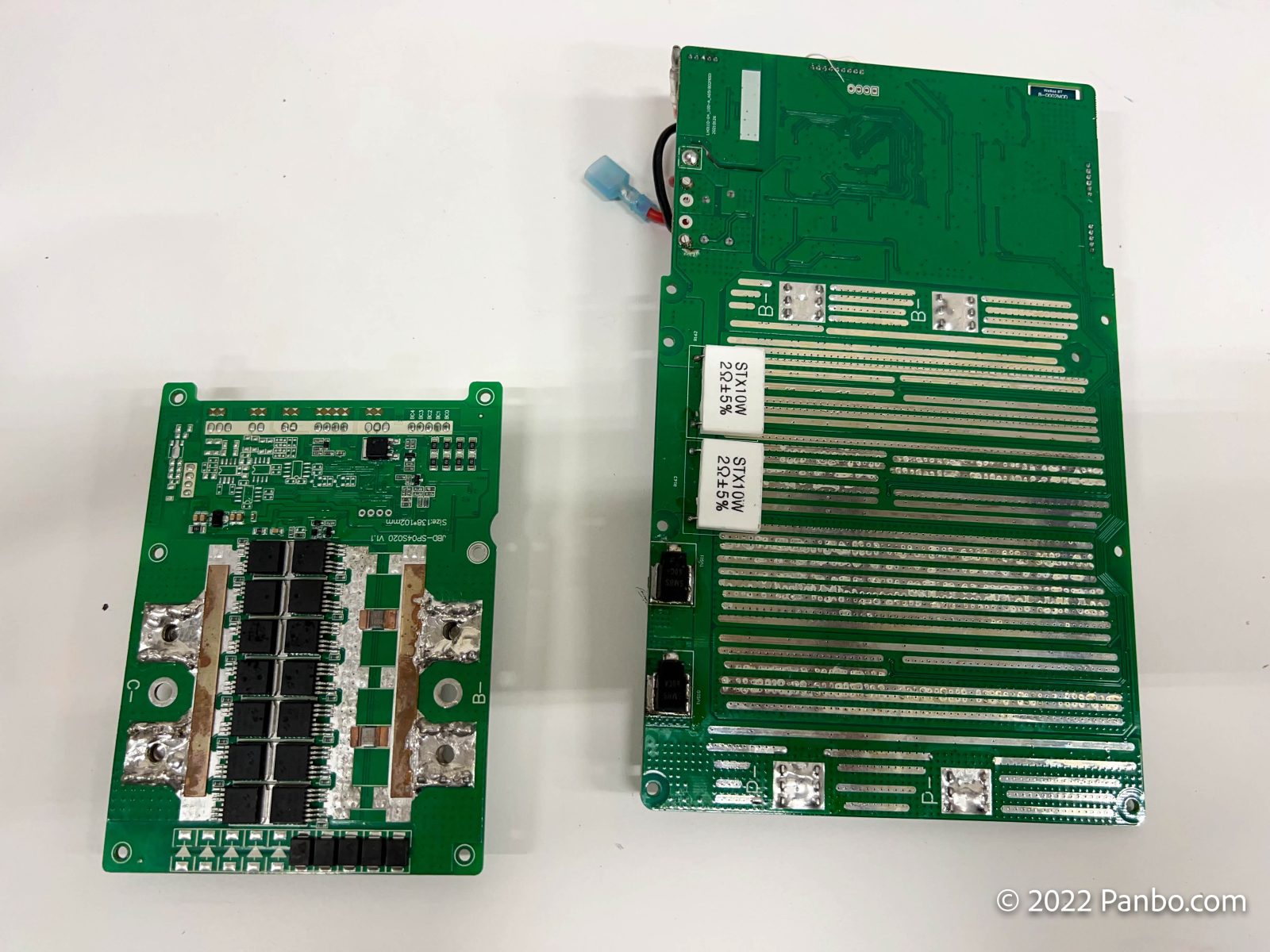
The story doesn’t end there. The Overkill BMS has FETs on both sides of the PCB, and they’re directly opposite each other. That’s not great for heat dissipation since the heat transfers through the board. The KV BMS only has FETs on one side, and they’re spaced out further for better cooling.
If it seems like I’m picking on the Overkill Solar BMS, I’m really not. The Overkill BMS is a good unit. I’ve been using one in my DIY LiFePO4 battery for almost a year with great success. But, I’m also aware that many, if not most, issues with LiFePO4 batteries are in the BMS and many of these come from overworked FETs.
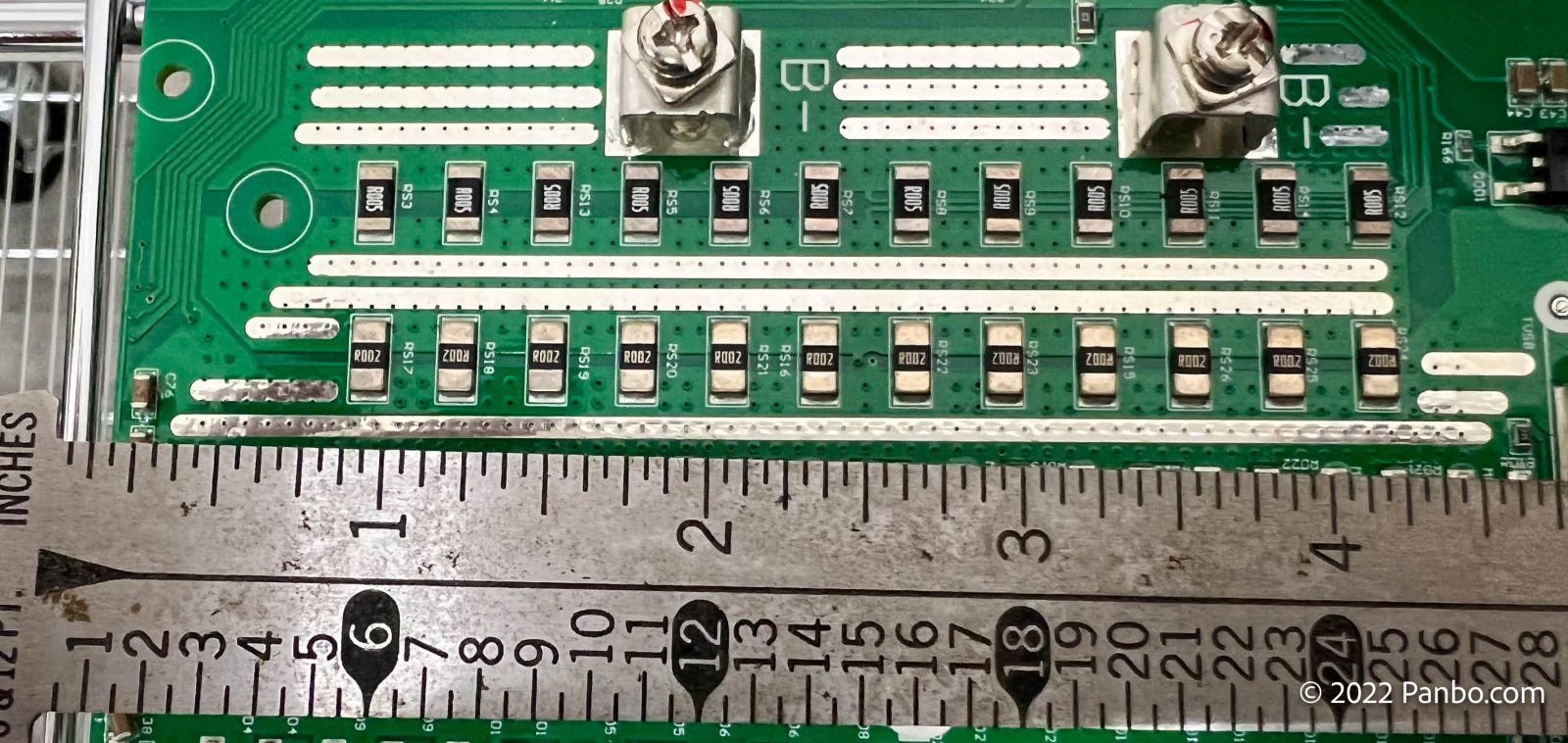
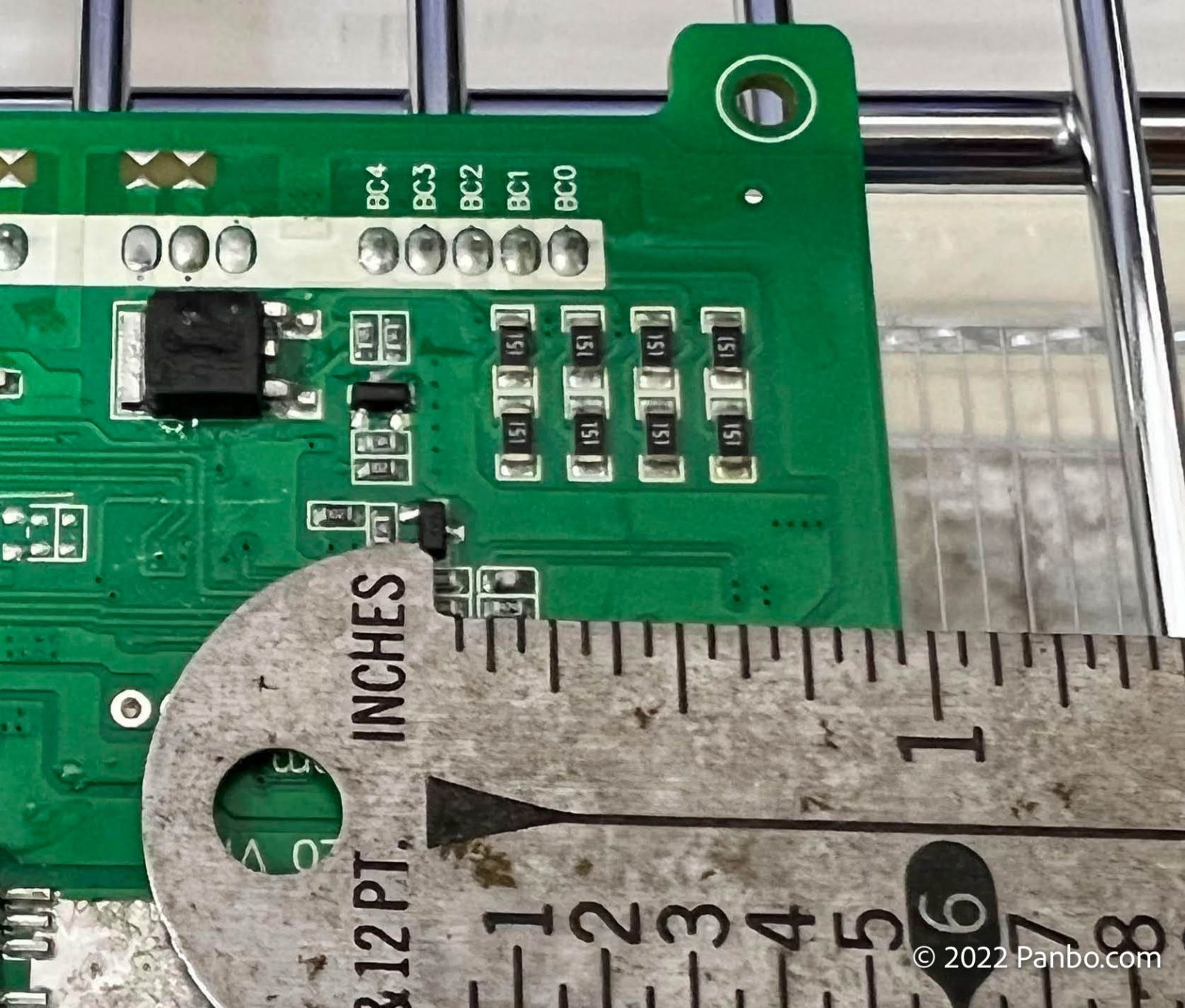
The differences don’t end with the FETs. Although some of these differences are subtle, they affect battery performance and longevity. The next significant difference I noticed comparing BMSes is the configuration of resistors. As a battery approaches fully charged, the BMS will use resistors to apply resistance to the charge current going to individual cells in the battery. This resistance is used to work out any imbalance in the level of charge between the individual cells.
As you can see in the photographs above, the KV BMS uses 24 resistors versus the Overkill Solar’s 8. When the resistors are creating resistance, they’re turning energy into heat. Unfortunately, I haven’t been able to determine the actual power rating of these resistors based on what’s printed on them. But, the combination of quantity, size, and spacing of the resistors certainly suggests the KV BMS will be able to generate more resistance and hence more closely balance its cells.
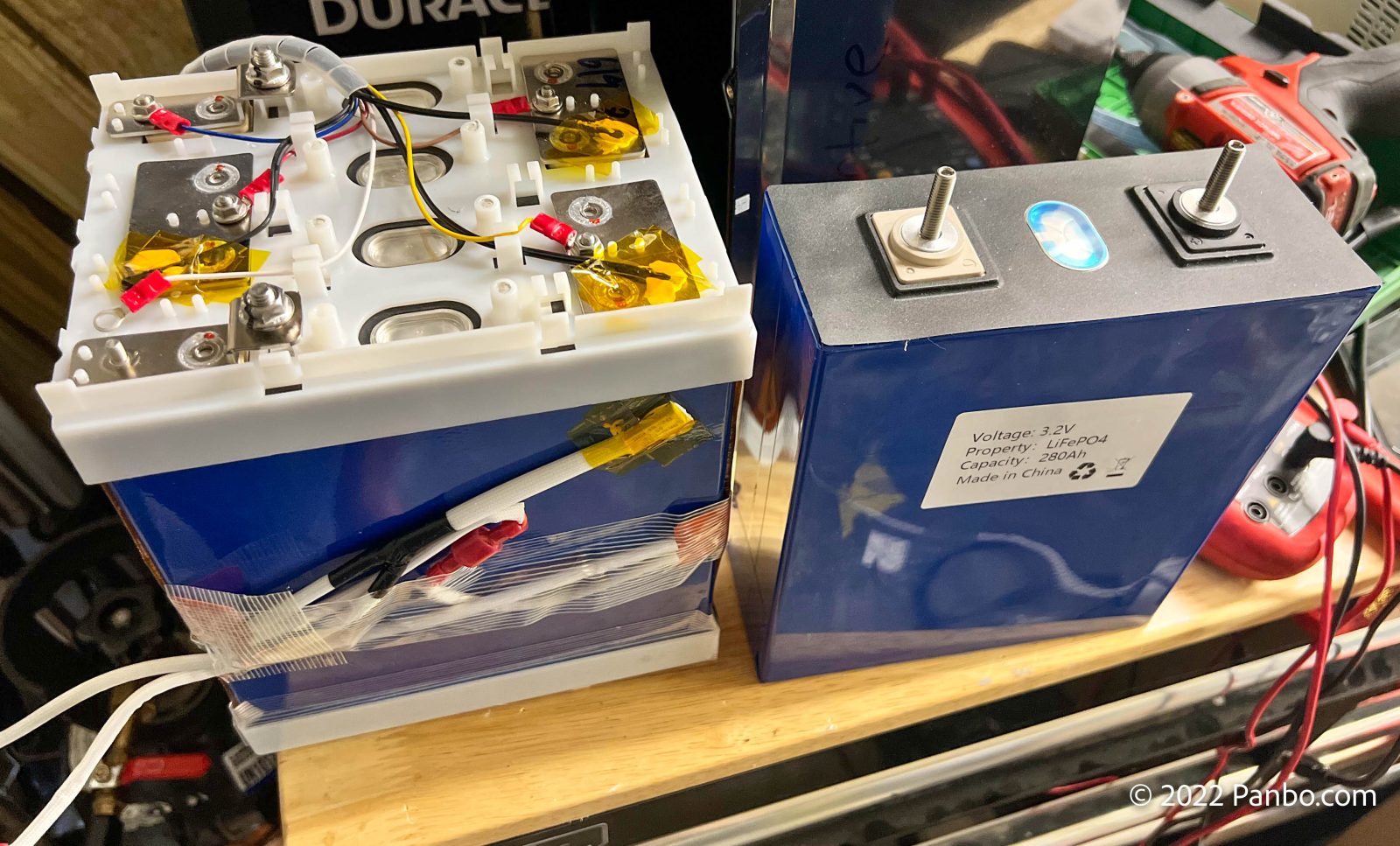
KiloVault uses quality cells from a reputable manufacturer. I often read information that suggests that regardless of what we think we’re getting, when buying cells from China you’re never getting the best cells they produce. But, that even B-grade or reject cells still provide the performance we need. I should be clear that I don’t have the knowledge or skills to determine too much about the actual cells used besides what’s contained on the data label and based on the real-world results from rundown tests.
Early testing results

I’ve conducted multiple rundown tests of KiloVault 3,600 watt-hour batteries. Each of these tests has proved the batteries capable of delivering well in excess of their rated capacity. In fact, each test has produced over 4,000-watt hours. When the capacity is measured in amp-hours, each 300 amp-hour rated battery has delivered more than 310 amp-hours.

One of the things you may notice in the rundown chart above are the knees in the results. As the battery is placed under load there’s a step down to its loaded voltage. I’m not actually sure what the small dip is from about an hour into the test until just before 18:00, but I suspect it’s from my voltage sense leads being bumped. For the next many hours the battery ranges between 13.2 and 12.6 volts. Then, as it gets to 12.6 volts and is nearing full discharge, it drops precipitously and continues until the test was discontinued around 11.5 volts.
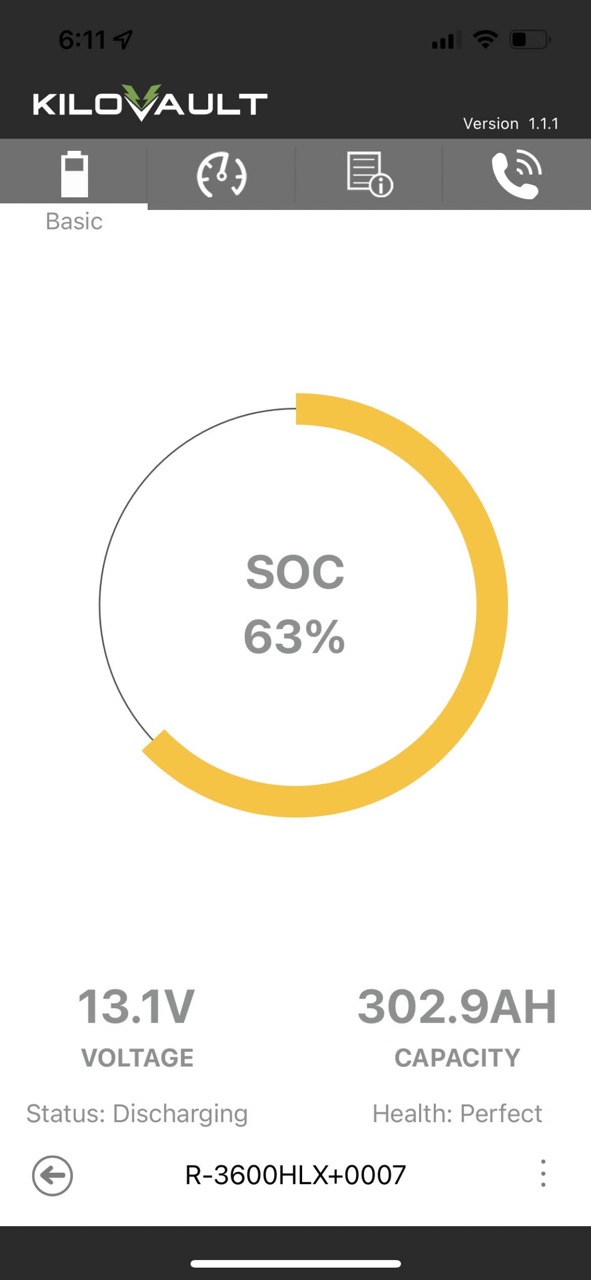
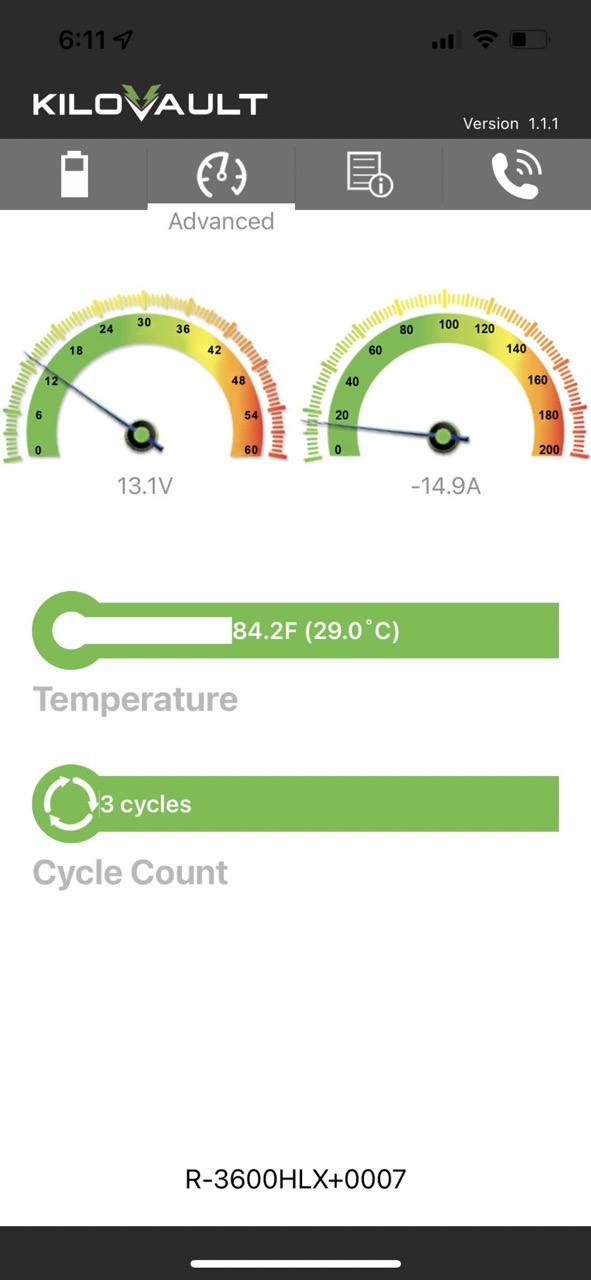
KiloVault has an app available in both the Apple and Google app stores. The app communicates with the batteries via Bluetooth and gives you access to basic information about the batteries. Unlike the rest of the battery, I felt the app comes up a little short. The app makes a few summary pieces of data available, like the voltage, state-of-charge, current, and cycle count. But Victron has spoiled me with the wealth of information even their battery monitor provides. I’d like more information, especially more historic information like total amp hours delivered. Ideally, I’d also love more operational specs like cell-level detail.
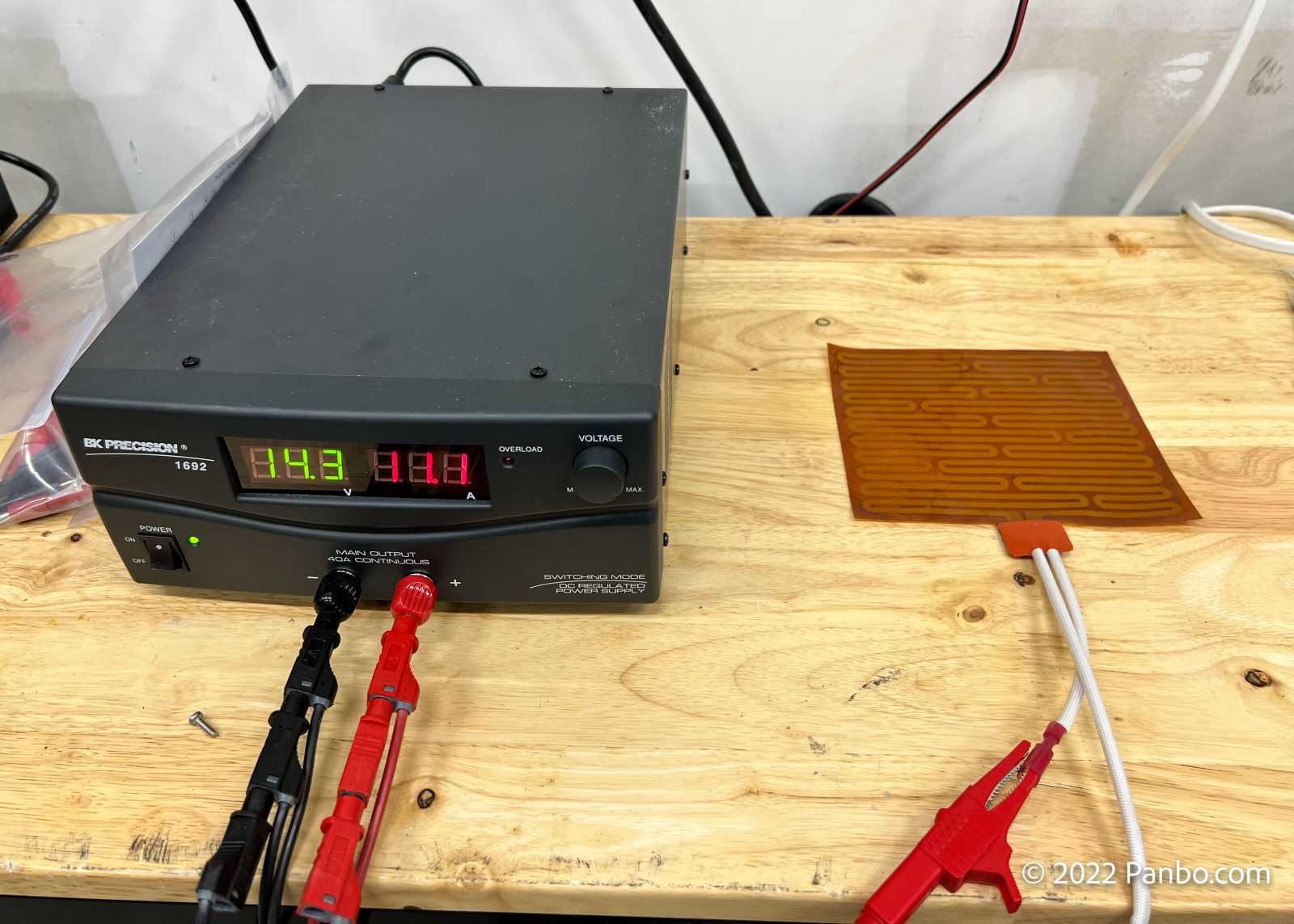
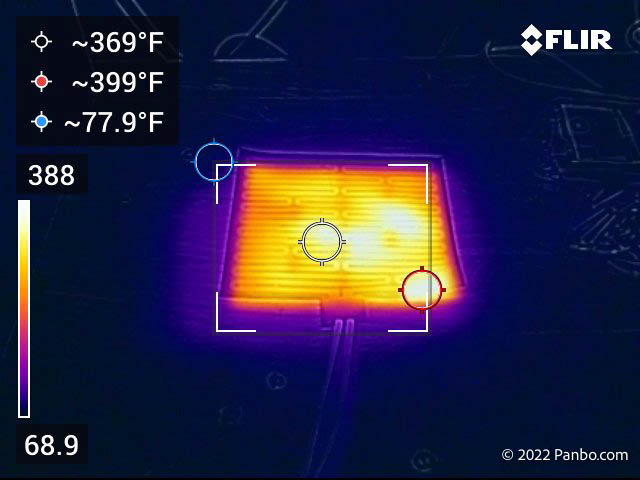
I was curious how much power the heating elements draw. The 100 amp hour battery I tore down has two heating elements. Based on what I saw from my testing it looks like these are roughly 10 amp heaters. At 10 amps of draw, the heating elements very quickly heated up to around 400 degrees. As you can see, I had the heater on a wooden work surface so I decided not to see how hot the element might get. But, what I did learn is that with both heating elements on, there’s a total of 20-amps of potential draw. But, based on how hot they get, I suspect that in practice they are run for short bursts.
A quick note on heating. During a recent conversation with Rod Collins from marinehowto.com, Rod explained the potential for trouble with battery balance when using battery heat on parallel-connected batteries without inter-battery communication. If one battery turns on its heat longer than others, it will charge less. That’s going to result in the batteries in the string being out of balance.
Without communication between the batteries, there’s no way for the batteries to balance. The challenge of balancing the batteries is worse on series-connected, but in this mode when a battery is heating it will also go into low-temperature protection mode which shuts down its output to just a few volts. This will trigger the low-voltage cutoff of an inverter but might yield odd results on other connected loads. That’s where KiloVault’s bridge comes into play, but it isn’t released yet. So, if you’re going to series connect the batteries in an environment where heat may be used, you’re best to wait.
Testing next steps
As I mentioned at the top, I’m going to be installing the two HLX+ 3600 batteries in my RV. That will give me a good opportunity to put them through their paces and get good, real-world testing done. I’ve already figured out that these batteries are a good bit larger than the four existing GC2 batteries. So, they won’t fit and I’ll have to find a new location for them. Based on what I’ve seen so far, I fully expect I’ll be back soon with very positive practical results.


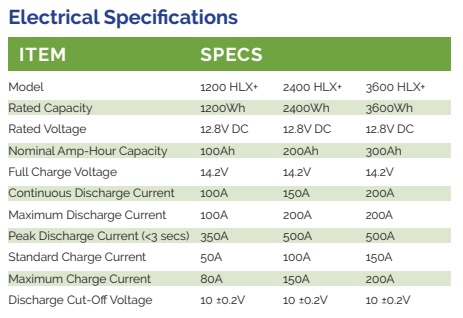
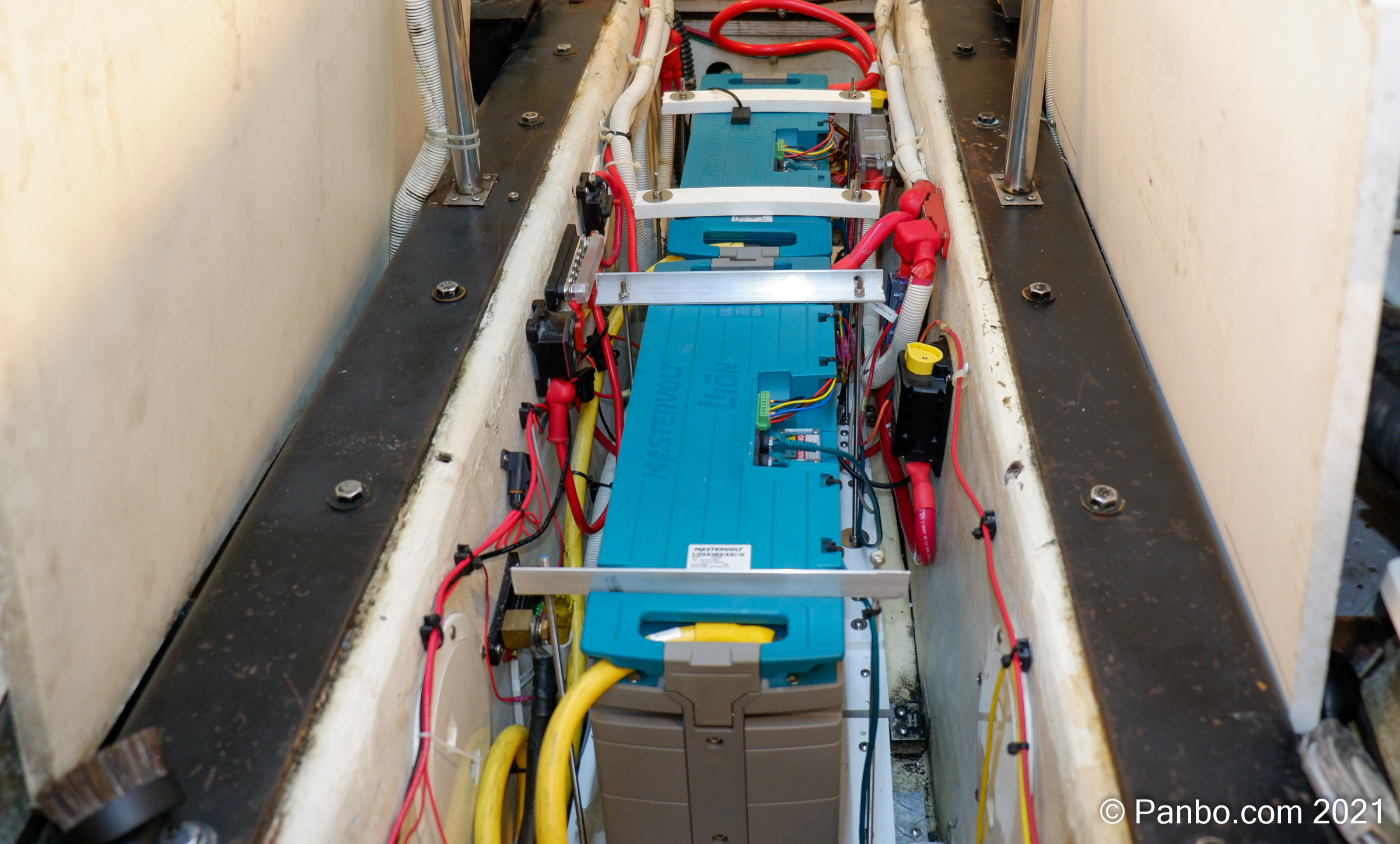
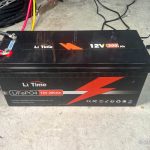
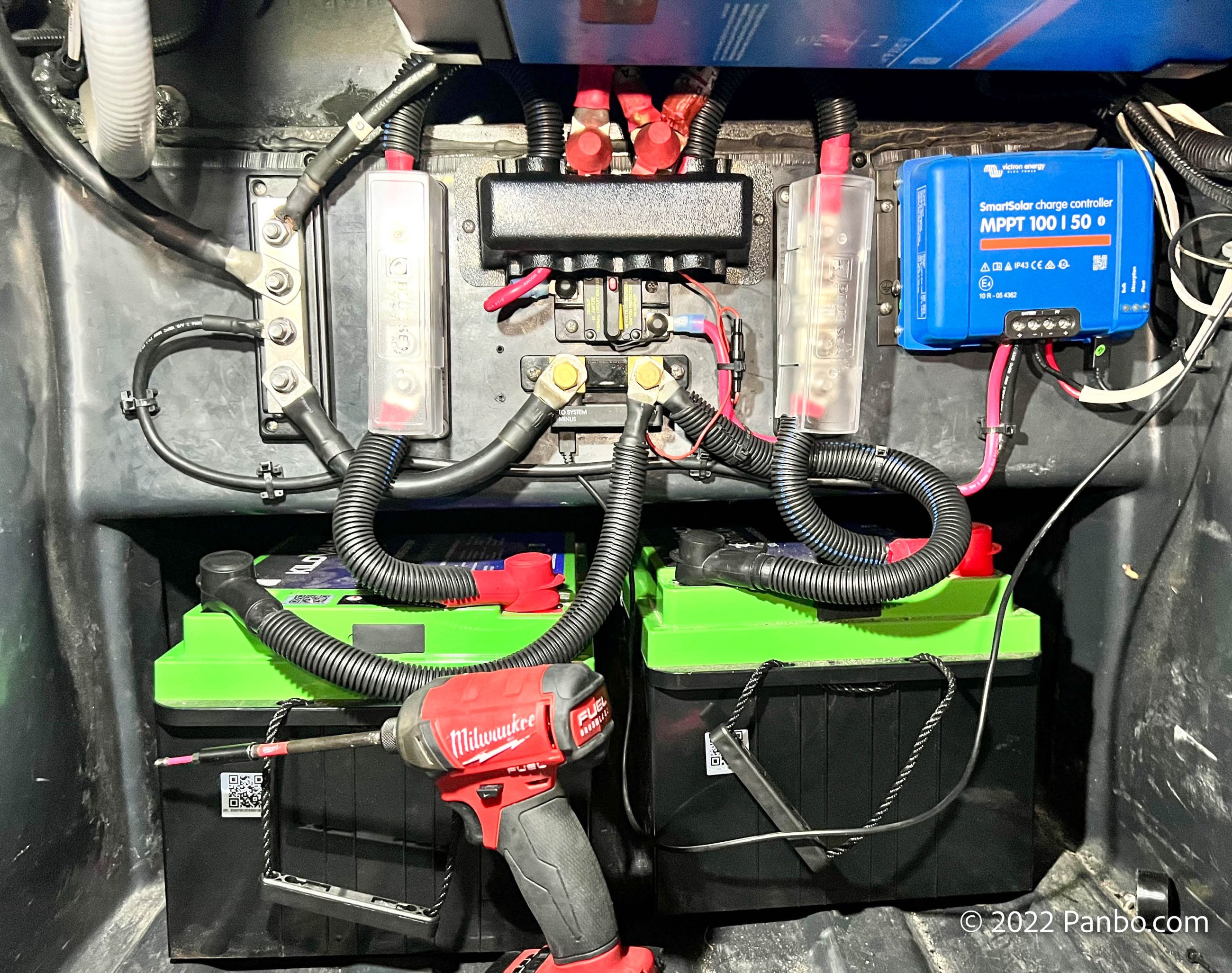
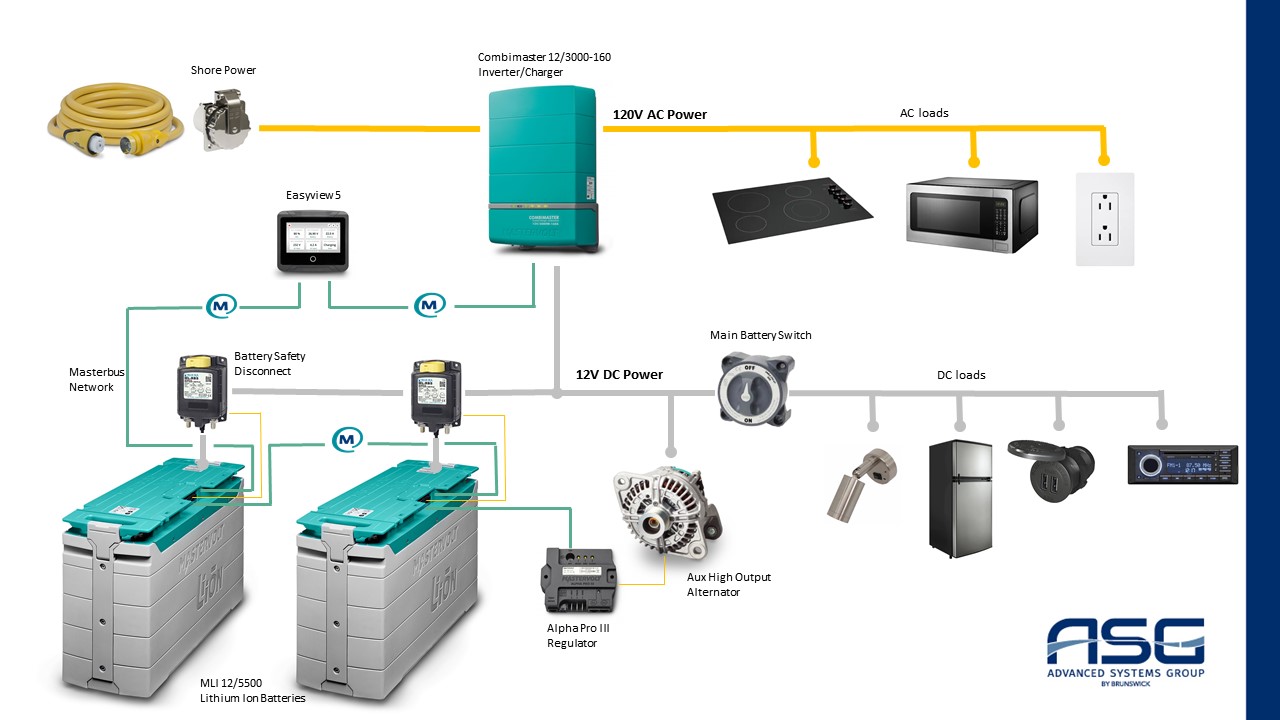








I replaced my AGM batteries with ChargeX Lithium batteries a year ago with excellent results. 1 Bank for bow thruster, 1 for stern thruster and 1 engine start/house. The only mistake I made was slightly undersizing the bow thruster battery which was easily remedied by adding another 50AH battery in parallel. Also added Victron shunts to the 3 banks and a new Xantrex inverter/charger. The internal battery BMS keeps all batteries within .01 volts and have been very happy with the results. I don’t see much mention of the ChargeX batteries but feel they are a great option. Especially like that they can be used as starter batteries which most lithium manufacturers discourage.
Great article Ben. We’ve been primarily using Kilovault batteries at BoatRx. The price point really makes them stand out.
good article.
you mention your using victron batteries ….
im curious why you didnt include them in your comparison table?
I don’t have Victron batteries in any of my boats or vehicles. Ben Ellison does have Victron batteries onboard Gizmo. But, Victron’s batteries are also more difficult to compare to a drop-in since they use an external BMS that can manage multiple batteries. That makes the price comparison tough.
-Ben S.
The newer Victron Superpack 200 ahr batteries with internal BMS run around $0.85 per watthour as a point of comparison. I noted that their continuous discharge is only 70 amps versus 150 amps for the 200 ahr KV.
Hi Greg, I first bench tested my Victron lithium battery system a year ago…
https://panbo.com/lost-bens-nope-were-in-the-lithium-mines-finding-gold/
… but then I had a medical setback and only got the Lynx Smart BMS and other components installed last winter. While I have a couple more things to do, and it’s not yet tested on the water, I remain very enthusiastic about the design. Literally bolting a battery-specific BMS plus shunt and contactor right between the main bus bars still seems brilliant, and the automated communications from batteries to Victron charge sources, relays etc. makes for safe operations without much user intervention or system knowledge. Then again, the monitoring and control is outstanding for an involved owner (or an installer). For instance, check out the public portion of my VRM site:
https://vrm.victronenergy.com/installation/105905/share/ea38a0bd
hi ben,
indeed i have just over past 4 months installed this very system
2 x lynx distributirs, lynx smart bms, 3 x 24V 200ah smart battery,
(plus quattro 24V 200A 8kw inverter /chgr, cerbo venus, … etc )
over past week ive been “stress testing it” …. with some 40% discharge cycles .
i must say that im very happy thus far,
i was attracted to it by the tight integration between smart BMS and smart batteries. (& system monitoring)
.. and yes for me .. like yourself, the ability to see under the hood!
albeit the battery data is “only “ avail via bluettoth/venus application…
its a shame this is not ingested by BMS and made avail to cerbo/system… my only real complaint.
aside from the lithium upgrade… one of the drivers was the “200A” charge rate … thus ensuring reduced generator run time and higher loading….(no more endless “low load” running generator to trickle that last 15% into AGMs)
for monitor (& control) im using signalk on seperate rpi, and various apps inc grafana for display,
the victron VRM (& cerbo) is a useful parallel system for monitoring… so if pi locks up, i still get important battery stuff.
Great to see move coverage and deep dive into one of the more affordable batteries. Have you looked into Chins at all? They also seem very popular.
I can’t believe I spent >$3300 at one point for 300Ah ReLiOn batteries, they weren’t even heated.
The last LiFePO4 battery I bought was a heated 200Ah LifeBlue battery for $1600. It was for a camper. Interestingly enough, the app is identical to the KiloVault app you show above, just a different color scheme. I wonder if they both have the same BMS or even the same manufacturer. Interestingly the LifeBlue has lower charge/discharge specs.
Ben, great article! One year ago I replace 4x Lifeline AGM 4Ds with 2X KV 3600 HLX batteries. I purchased the batteries from Rod Collins and upgraded the electrical system with his expert and patient consultation. The batteries have been working great. I used the KV bluetooth app for daily checks of overall battery charging/discharging status INCLUDING cell level detail. As KV states in their operation manual:
” Below the alarm indicators are 4 battery shaped icons. They represent the 4 cells that make up the battery. Their color does not indicate anything. They are always the same color. Below each battery icon is a number showing each cell’s voltage in mV (millivolts). The color of the numbers do not mean anything. They’re always the same color. The difference between the highest and lowest should be 300mV or less. Tap anywhere to dismiss this screen.”
By default, my app doesn’t show the individual cell voltages. I’ve learned there are passwords for additional levels of detail. I’m away from the batteries right now but will be back in a few days. I’ll test that added functionality then and update the article once I do.
-Ben S.
Question, do these batteries have a UL listing, are the marine rated and can the BMS discharge high enough current to potentially start a engine? Thanks !
They are UL 1973 certified. But, if I understand the certification process correctly, there are multiple layers of certification. I’ve reached out to KV for clarification on exactly what level of certification these carry. The BMS is listed as handling 650+ amps per battery for over 3.5 seconds. However KV still says they are not designed for engine starting or the inrush loads associated with engine starting.
-Ben S.
Ryan, For my ChargeX install of 2 100AH batteries in parallel, ChargeX claims 2000 CCA for 5 seconds which has no problem starting my single 260 Yanmar diesel even after a winter storage cold start. I only have a year of use but haven’t missed a beat so far.
Kevin Shea
Looks like a nice battery, especially with the CANBus ports. Will that work with Wakespeed’s WS500 regulator to stop charging if the BMS needs to disconnect/protect the battery? For comparison, does their BMS have a heat sink like Overkill Solar’s BMS?
Finally one more battery for comparison, SOK (no heater, no canbus but servicable) has been getting good reviews and they’ve recently introduces a sealed case version. With the cheaper options I’d want a couple in parallel for redundancy.
I’ve been researching lithium batteries as a replacement for my two AGM batteries in my camper van. The current location is outside the van in the rear passenger side. Can this battery remain outside?
I’ve installed these a few times for offgrid home systems, upon my recommendation actually. For those that are unaware, kilovault is the “house brand” of AltE, a reputable vendor on an things RE. I myself use the kilovault wall mounted Habs (to power my offgrid home) which are 48v 150ah batteries… Kinda like the big brothers to the HLX series. They have performed exceedingly well thus far. I would exercise caution if using the external battery balancer module for the HLXs however…they are really not necessary, and I had one catch fire a few months ago. The batteries themselves were fine, it was just the balancer (which is not actually made by kilovault incidently, though it bears the branding). All in all, these are excellent batteries, and for what you get for the price, and the AltE warranty to replace in house, it’s hard to beat.
I recently installed 3 of the 3600 HLX+ batteries on our boat. So far, battery performance has been very impressive. The batteries arrived with cells well-balanced, and they have remained very tightly balanced thus far.
However, I agree with Ben that the smartphone app is overdue for an update. There’s no reason that a password (1234) should be required every time you want to look at individual cell voltages. And when do you display cell voltages on an iPhone, the red numerals over semi-transparent gray background are nearly illegible. The Android app is a little better FWIW.
Also, the promised HLX+ Bridge has been listed as “coming soon” since at least November. That’s not “soon” in my book… that’s classic VaporWare. That’s too bad, because it sounds like it will add some promising capabilities.
We’ve had four Kilovault 3600s (heated) installed on our boat since May 2020… I find that the cells in each battery are within 5mv of each other during Charge and Discharge, but during Float the can be as much as 100mv out… Float in my case is pretty much 0 amps in or out of the battery at 13.5v…
Agree the app needs work… get rid of the password, and show the battery voltage to two or three decimal places… right now they show some sort of rounded voltage to one decimal place and it never matches what the individual cells avg to in the password protected screen…
Thanks for this article. I have these batteries newly installed at my house. My problem tho… the app. According to the supplier I got them from, the app is never correct for Staye of charge. So one battery reads 25% and one reads 49% but they say to ignore that. Any ideas? I’m desperate to have a more precise reading. THANK YOU!
Hi Laura. In my experience, the internal BMS does a pretty good job tracking state of charge (the app simply displays whatever percentage the BMS reports to it). The tracking/calculation isn’t perfect, but the reported SOC for my three batteries all stay pretty well synchronized. If you don’t reach a full charge periodically to reset the counters to 100%, then they can drift apart, but I don’t think I’ve ever seen more than maybe 5-6% difference in the reported SOC, even after running for weeks without a reset / full charge.
I think the 25% vs 49% that you’re setting sounds like a much bigger discrepancy than you should be seeing, unless your batteries are going a long, long time without getting a full recharge. Kilovault did issue a firmware update recently, and gradual SOC tracking drift is one of the issues it’s supposed to correct. You can contact KV support directly about that via their website. I found them to be very helpful.
That said, I think the 25% vs 49% that you’re setting sounds like a much bigger discrepancy than
Can no longer find these batteries (or the manufacturer).
From what I can find, Kilovault went out of business some time in the last few weeks (March 2024).